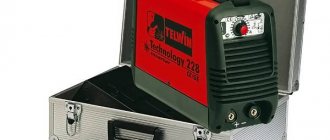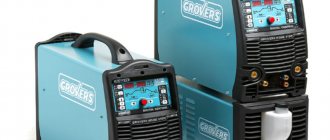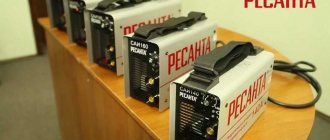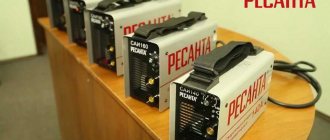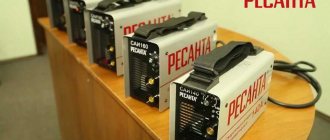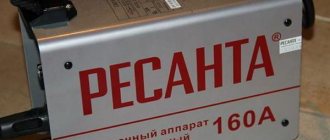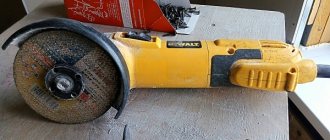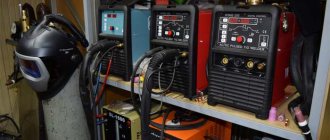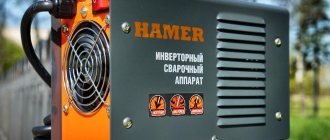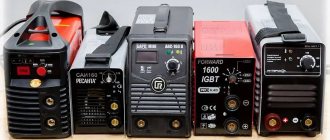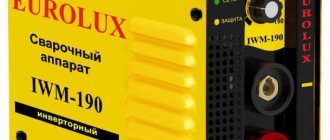When choosing a welding machine, you need to delve into its power, corresponding consumables and duty cycle. The required input power and the type of voltage received play a big role. The quality of the welded joint and the ability to work with different thicknesses of metal depend on the operating principle of the device, be it a transformer, semi-automatic device or inverter.
The best manufacturers of welding machines - which company to choose
If in everyday life you need a welding machine from time to time, but you don’t have time to delve into all the differences and features, then you can choose quality products from trusted manufacturers from the list below:
- Aurora;
- Fronius;
- Blueweld;
- Daewoo;
- Fubag.
Any of these devices will cope with tasks in a private home and yard. But if you plan to engage in welding work at a semi-professional level or even full-time, then the capabilities of specific models in certain production conditions play a big role. Therefore, it is important to familiarize yourself with a detailed review of common welding machines, which will help you find “yours.”
Recommendations: 13 best masks for welders
15 best welding machines
15 best welding inverters
Editor's Choice
Of all the above models, we recommend the entry-level device Resanta SAI-220 for private use in a country house or country house. It is one of the recognized leaders in its niche and, according to statistics, is one of the most frequently purchased inverters.
From the middle price range, our choice fell on the Resanta SAI-250K device, which has all the advantages of its predecessors, but offers expanded capabilities.
And finally, professional devices. Here Telwin Technology TIG230DC HF/LIFT+AC comes out on top with consistent build quality and an optimal balance between quality and user performance.
Operating principle and design of the welding machine
Welding equipment has many varieties, but most models share a common operating principle, which is to heat and melt the edges of the metal and filler material with an electric arc, and create a single crystal lattice in the overlay weld.
To do this, a ground cable, designated “-”, is connected to the parts to be welded. There is a wire in the torch or holder with the opposite value “+”. Closing the contacts leads to the formation of an electric arc, whose temperature reaches 5000 degrees. This allows you to melt most types of metals.
To fully form the seam, consumables are used. These are coated electrodes or welding wire. Melting together with the base material, these steels are mixed, which gives strength and volume to the applied seam. This makes the connection difficult to break, break or bend.
When the metal becomes liquid, its molecules can interact with the surrounding air, which leads to the release of carbon and the formation of pores in the weld structure. Such a connection is not capable of sealing water or gas pressure; It has poor rupture and refraction performance.
To prevent a chemical reaction, a protective environment in the form of a gas cloud is used. It is formed due to a special coating of the coated electrodes, which creates an impenetrable cloud layer that prevents the penetration of the atmosphere into the weld pool area. In the case of a semi-automatic machine, where the wire is fed without coating, this role is performed by a separate gas from a cylinder (carbon dioxide or a mixture with argon).
The process of creating a stable electric arc that is safe to hold in the welder’s hands is possible due to changes in the characteristics of the welding current occurring inside the machine.
The welding machine consists of the following elements:
- transformer with two windings;
- diode bridge;
- choke with capacitors;
- Control block;
- working elements (cables, holder).
The principle of operation is to pass electricity through several stages. The input voltage goes to the primary winding. Due to the action of electromagnetic induction, the current strength (amps) increases several hundred times, and the volts drop to a safe value.
In the case of a conventional welding transformer, parts can be connected already at this stage. In inverters and semi-automatic machines, the altered current from the secondary coil undergoes additional transformations to increase the frequency.
Advantages
This technique has significant advantages, which is why it has earned such wide popularity among many users. The main ones include:
- A wide selection of products on the modern market from domestic and foreign manufacturers;
- Relatively low cost of equipment;
- High productivity during operation;
- Availability of consumables;
- Versatility, due to the choice of different operating modes and parameters;
- Availability of additional functions that improve performance.
Types of welding machines
Despite operating from an electrical network, welding devices have differences in the internal structure and technique of performing the work, which affects the quality of the seam and the applicability of the devices in certain conditions.
Transformers
They represent the cheapest segment of the market for such products. They have a very simple structure and light weight (household versions). Industrial models are distinguished by voluminous bodies and decent weight. Suitable for welding carbon steel in all spatial positions.
It is better to use for simple metal structures where the seams will not be subject to increased load. Using a transformer, you can weld doors, gates, and a water tank.
Advantages:
- affordable price;
- easy operation;
- easy repair;
- Possibility of power supply from a household network;
- current adjustment.
Flaws:
- increased noise from work;
- does not cook alloy steels and cast iron well;
- uncomfortable handle; change in current strength.
Inverters
This is an advanced version of transformers with additional elements in its composition. In addition to two windings, which play a key role in lowering the voltage (V) and increasing the current (A), inverters have a diode bridge that rectifies alternating current to direct current without oscillation.
Then it is lowered and goes to a filter of capacitors and a choke to be re-converted to an alternating frequency, but with a frequency that has already increased tens of times. This results in smoother, stronger seams.
Inverters are good at welding not only sheet iron (fence, gates, tanks), but are also excellent for creating plumbing and heating. Due to the high frequency, they can weld alloy steels and cast iron. Its small weight allows you to hang it on your shoulder by a belt and cook it at a height.
Advantages:
- very light;
- seams are smoother and stronger;
- high sealing performance of connections;
- power supply from household network;
- wide range of settings;
- many auxiliary functions for novice welders.
Flaws:
- are more expensive than transformers;
- more elements in the electrical circuit that can fail;
- expensive repairs;
- Some models do not support work with all electrode diameters.
Semi-automatic
The third category of welding machines combines all the elements from the previous two: semi-automatic machines have both a transformer and a rectifying unit. But instead of using coated electrodes, wire is fed from a drum with a reel.
This filler material is capable of being supplied continuously, allowing the weld to be welded for a long time without stopping, which is convenient for long structures (fuel tanks, water filters, continuous welding of metal sheets).
The supply is started by pressing a button on the torch, at the same time shielding gas is sent to the welding zone through another channel in the nozzle. The drum rotates and the wire is delivered due to the pressure roller mechanism and the cable channel.
If you change the filler material to stainless wire, then the device is suitable not only for carbon steel. With an additive diameter of 0.8 mm, you can quickly weld thin metal on car bodies.
Advantages:
- beautiful even seams;
- the ability to continuously weld;
- high performance;
- there is no slag on the surface that interferes with visibility during welding;
- quick post-processing of seams;
- ability to weld very thin sides.
Flaws:
- large dimensions of the device;
- require a gas cylinder and hose;
- Wire on spools is more expensive than electrodes.
Advantages and disadvantages of inverter arc welding
Serial production of inverters - rectifiers with a transistor inverter - began in the 80s of the twentieth century. In these devices, the current passing through the semiconductor is rectified and then smoothed by a special filter. There is a conversion of direct current with a frequency of 50 Hz into a higher frequency alternating current. It then goes into a mini-transformer, which reduces the voltage and increases the current. The current then passes through a high-pass filter and a rectifier. An electric arc is formed by direct current supplied to the electrodes.
In addition to the main advantage of inverter devices - increasing the frequency of the current, they also have other advantages, such as:
- Economical - with a high efficiency of the power supply, reaching 85–95%, energy losses are insignificant. The equipment can be connected to a regular household outlet.
- Long time of continuous operation.
- Wide range of current adjustment, which allows the use of various electrodes, including ultra-thin ones.
- Smooth adjustment of current and voltage.
- Easy ignition and good arc stabilization, controlled electronically.
- Availability of protection against voltage surges.
- Obtaining a high-quality welded joint, the ability to work in different positions, minimal splashing of molten metal.
- Ability to work with various materials, including those that are difficult to weld.
- High electrical safety.
Before choosing arc welding with inverters, it is worth learning about the disadvantages of the equipment:
- Such equipment costs much more than conventional transformer equipment. If there is a need for repairs, they will also be quite expensive. So, to replace a block of IGBT power transistors you will have to pay a third or half of the cost of new equipment.
- All inverters are equipped with cooling coolers. During operation of the device, dust and metal particles are drawn into the cooler, which can cause a short circuit. To avoid such problems, welding equipment requires frequent air blowing and cleaning with a soft brush. Such measures are especially important in production and construction sites.
- The electronics of inverter arc welding machines are highly sensitive to moisture and low temperatures, as they can cause condensation. For this reason, working with inverters in winter is somewhat difficult. In addition, equipment must be stored correctly in winter (an unheated garage is unsuitable for storage).
- May cause interference to the main power supply.
For novice welders who decide to choose arc welding with an inverter, the device will make it easier to complete the task. For more experienced specialists, it will not be difficult to quickly obtain a high-quality weld. Light weight and dimensions ensure equipment mobility. Automation, compactness, functionality – these are the advantages of inverters that pay off the money spent on their purchase.
Welding machine selection parameters
When choosing welding equipment, it is necessary to take into account the upcoming types of work and local conditions. Knowing the main parameters and their impact on the result, you can make an informed choice.
Dietary choices
To operate the welding machine, it must be connected to the network. There are models with 220 and 380V. Three-phase equipment cannot be connected to a household outlet and requires a special connector and large cross-section cables. Therefore, for welding at home (dacha, garage, apartment) you will need a 220V model.
It is also worth considering the range of current consumption for normal operation. The parameters indicated in the documentation 220-230V mean that the equipment will be able to work well at a stable voltage in the network.
If there are frequent upward surges, the device may burn out (without installed protection). When the current in the network drops, the device will cook poorly (frequent defects in the form of lack of penetration and sticking of the electrode to the surface). In this case, you will need devices with an extended input current range of 140-250V.
In industrial use, most panels are equipped with three phases, which allows you to connect powerful devices and weld 10-30 mm steel. But to do this, they must be grounded with a separate line to the circuit so that the breakdown of the current does not lead to the death of the worker. In household versions, grounding is included in the structure of the socket and plug of the device itself.
Welding current range
This is a very important parameter on which the machine’s ability to weld metal of a certain thickness depends. It is measured in amperes and denoted by the letter A. The indicator has two values - minimum and maximum, and both are important for different types of work.
To weld thick elements (channel, angle, rail), high values of 300-500 A are needed. This will allow not only to apply a seam from above, but also to melt the product deeply into the depth.
In opposite cases, when work with thin iron is required (welding sheets of 0.8 -1.0 mm to a fence, making containers from tin), minimum current values are important. Devices with 20-30 A are useful here. If the threshold is 60-80 A, then the welding will leave holes and additional resistance will need to be installed to reduce the current.
The form of current regulation is also important here. If there is a toggle switch on the case with values of 30, 50, 70, 90, 120 A, then this will allow you to set the power only approximately. It may turn out that 90 A is not enough for good penetration, but 110 A is already too much. Smooth adjustment with digital display and change by unit gives more precise settings.
Electrode diameter
It is difficult for a non-specialist to determine by eye the required current strength by looking at the thickness of the metal, so an additional parameter is the diameter of the welding electrode, which the equipment supports.
To weld thin car bodies, it is best to buy 0.8 mm semi-automatic wire or 1.6-2 mm coated electrodes. For welding pipes, 3 mm is best suited, and in the case of making gates and fences, it is worth buying a machine with an electrode diameter of up to 4-5 mm.
Open circuit voltage
This is not the mains voltage for power supply, but an indicator of the current present at the moment when the equipment is turned on, but the arc is not ignited. This parameter indicates how easy it will be to ignite the electrode.
Values of 35-60 V should be chosen only by experienced welders, since they require a trained hand and the ability to maintain a gap of 3-5 mm between the end of the electrode and the metal surface.
Beginning welders should look for models with an idle value of 70-90 V, which will allow them not to knock on the joint for a long time, but to immediately light the arc and start welding.
When contact is established, the voltage automatically drops to 12 V to protect the worker from touching the parts being welded.
Duty cycle
This is an indicator of the temporary use of equipment at maximum welding mode. For example, a value of 60% indicates that out of ten minutes of operation at the highest ampere value, the device will be able to cook for six minutes, and it needs to cool for four.
If you plan to use the device for welding doors, fences, heating, where there is a lot of preparatory work as the work progresses, then the device will have time to rest and a cycle of 60% is quite enough. Moreover, not each of these processes requires welding at maximum power.
In the case of more professional activities with daily employment (manufacturing safes, welding machines) or carrying out work on a volumetric structure (large water tank), where there are long straight seams and work can be carried out for a long time, it is better to purchase models with a cycle rate of 80-100% . The latter are generally designed for continuous operation throughout the entire switching time.
Device weight
This parameter plays a role during frequent transportation. When the main work is not carried out in a workshop or garage, but each time in a new place (creating heating for people, repair work on a water supply system), then carrying a heavy apparatus weighing 10 kg is very inconvenient.
During the day it may need to be moved several times, which takes additional strength. Therefore, for a mobile lifestyle, light models weighing 3-5 kg are needed, and for stationary work, any device by weight is suitable.
But the weight of the apparatus is also important for types of work in a spatial position. If the weld involves creating a connection at height (supports, balconies, large greenhouses, canopies), then the welder often has to lift the equipment with him. Lightweight models weighing 2-3 kg, worn on the shoulder through a belt, greatly simplify the performance of such tasks.
Maximum power of the device
This parameter is designated kW and can vary from 2.5 to 10. It is necessary to take these values into account when working in houses with old wiring and meters, which may not be designed for high loads and plugs will constantly be knocked out. This will not allow welding and the device will be useless.
In this case, you need devices with a minimum rating of 2.5-3.5 kW. For industrial conditions or new wiring and modern meters designed for air conditioners, washing machines and irons, you can use more powerful devices.
But this parameter implies the value at maximum operating mode. For example, the value of 300 A on the scale. If most types of work in a house with old wiring and a meter need to be performed at 200 A, then there should be no problems.
Cable length and cross-section
Typically, 1.5-1.8 m cables for the holder and ground are supplied with magazine devices. This is quite enough to cook on a workbench in the garage or connect products on the floor. This type of equipment is convenient for assembling small containers and carrying out repair work. But making a door or gate will be inconvenient due to the dimensions of the structure.
Most doors are at least 1900mm in length, which will require repositioning the machine to weld all corners. When working in a greenhouse, which is 2.5 m in height, the welding equipment will have to be lifted onto an additional rack. Therefore, it is better to buy a cable 3 m or more long here.
But when increasing the path for current, it is worth remembering the cross-section of the wires. For cables from 3 to 5 meters, a cable diameter with a winding of at least 10 mm is required. This will not lead to overheating and melting of the wire.
It is also worth increasing the strength of the welding current on a long cable in order to overcome the increased resistance from the cross-section, so the machine that is planned to work around large products or at height should have a reserve of this value.
Type of current
Welding machines have several types of voltage for making a seam.
Transformers are powered by alternating current, which is suitable for simple structures without increased loads (greenhouse, doors, fence).
Inverters operate using alternating current, but at a higher frequency, which makes them practical for welding pipes and containers.
Devices with direct current provide greater freedom in the types of metals being welded and interact well with stainless steels (towel rails, tanks, SUV bumpers). This value is indicated in the device characteristics by a straight or wavy line, which implies constant or alternating voltage.
Extra options
1. The “arc forced” technology will be convenient for novice welders, since it prevents the electrode from sticking when its end approaches the workpiece unsuccessfully. When the hand is not trained to maintain a gap of 3-5 mm, the end of the consumable often sticks, which spoils the seam and slows down the entire process. Boosting allows the machine to independently increase the current for 1-2 s to prevent sticking and continue welding at the set mode.
2. Hot start function makes it easy to start the arc. To do this, you need to tap the end of the electrode on the beginning of the parts to be welded or on an additional roughing plate. Repelling the coating from impacts complicates combustion and reduces the protection of the weld pool. With a “hot start,” increased voltage is supplied to the electrode at the moment of ignition, which facilitates ignition of the arc.
3. Overheating protection will automatically turn off the device and signal this with a burning light, which will prevent the transformer or diode bridge from burning out. This helps prevent unscheduled equipment repairs when you get too carried away with your work, and does not require periodically checking the temperature of the device with your hands.
Criteria for selecting arc welding equipment
In order to choose the right arc welding equipment, you should pay attention to the following:
- Useful functions of the equipment, which we will discuss further.
- The presence of stages of protection against overheating and short circuit, as well as a cooling system - built-in fan. It can work continuously or turn on when the equipment heats up to a certain temperature.
- The cost of an arc welding machine, its components and their quality.
- A reputable manufacturing company, warranty, service.
The listed parameters must be taken into account when choosing any equipment for electric arc welding. Below we will talk about the features of individual types of devices for electric welding, depending on the technology used.
Which welding machine to choose
1. For welding pipes for heating and water, it is advisable to have an inverter with a current range of 20-200 A, cables of 1.8 m, power supply of 140-250 V, weight of 3 kg and a cycle of 60%.
2. To repair cars that require welding on a thick frame and a thin body, a semi-automatic machine with the ability to install 0.8-1.2 mm wire, 20-300 A, a cable channel of 3 m, and a power supply of 180-250 V will be optimal Cyclicity is suitable 80-100%. The weight of the device can be 6 kg or more, but this is not important since the body is placed on a trolley with protective gas and moved on wheels. For large enterprises, a three-phase 380 V model makes sense.
3. For welding doors, fences and gates, a simple 40-250 A transformer, with a 2 m cable, and a cyclicity of 60% is sufficient. The power supply depends on the local network and can be 220-230 V. If the meter in the house is old, then it is better to find a low-power model of 3.5-4 kW.
4. For work at heights (welding greenhouses, supports, canopies, balconies) you need a lightweight inverter weighing 2-3 kg, with a 1.8 meter cable and a belt fastening. The current strength can be 30-180 A, since the profile has a metal wall thickness of no more than 2 mm.
5. Boilers for furnaces and various heat exchangers require deep welding due to thick walls. Here you need a powerful inverter of 300-500 A with a cyclicity of 80-100% and 7.5 kW. It should support work with electrodes 5-6 mm in diameter. Three-phase power supply is possible.
Why buy welding rectifiers
Welding rectifiers are similar to classic transformers: the frequency of the current in them does not change, but the voltage decreases and the force increases on the windings of the power converter. Unlike transformer devices, current is passed through silicon or selenium rectifiers (semiconductor valves through which current flows in one direction). The electrodes are supplied not with alternating current (as in transformers), but with direct current, which helps to obtain a stable electric arc.
Pros and cons of MMA transformers
Such devices are still very popular today because they are low cost and easy to use. Electricity in this device is converted by a power transformer operating at a frequency of 50 Hz. The electric current first flows to the stationary primary winding, which is represented by an insulated wire. After the magnetic flux is formed, the voltage passes to the secondary winding, which has no insulation and moves. A magnetic field arises. Since the windings have different numbers of turns, it becomes possible to obtain the necessary voltage and current indicators: the more turns there are in the secondary winding, the higher the outgoing current. You can increase the welding current in another way - by bringing the coils closer to each other.
The advantages of transformers include:
- Affordable prices;
- Simple design;
- Reliability.
Among the disadvantages, it is worth noting the significant weight of most transformer models, high noise levels, and relatively low efficiency - no more than 80%. In addition, transformers consume a lot of electricity, so it is not recommended to connect them to a stationary power supply.
Features of the welding station
A welding station is usually called a welder's workplace. It includes everything necessary for the full implementation of various types of work. The post and all materials do not always have to be located in a specially prepared room.
If necessary, welding equipment is moved to an open area. Therefore, posts are divided into two types - stationary and mobile (mobile). Welding transformers will be located at the workplace to carry out welding with alternating current, or a rectifier for direct voltage. Welding stations often include:
- Switch.
- Power network.
- Electric holder.
- Welding cables.
- Power supply.
- Exhaust probe.
The post cabin must also have its own specific dimensions: 1.5 m and at least 2 meters in height. Inside it is equipped with a metal table; an exhaust probe must be installed in the upper part. The table has one or more drawers for storing any tool. You should never forget about personal protective equipment; this includes overalls, which must be issued to the welder.
Difference between AC and DC welding
Understanding the differences between alternating and direct current, as well as the features of welding machines that produce them, let’s consider the difference in welding.
AC Welding
DC welding
The arc on alternating current burns less stably; random attenuation is possible with a slight change in the gap between the electrode and the product. There is a characteristic crackling sound. It is more difficult to manipulate the arc, sometimes it “walks”, and it is more difficult to set the shape of the seam.
When welding with alternating current, there is metal spattering, the arc “spits”. AC electrodes are consumed faster. During the execution of ceiling and vertical welds, the transfer of filler metal is complicated; some of it accumulates downwards under the influence of gravity.
But welding machines operating on alternating current are cheaper than rectifiers and inverters. They have the simplest design and internal components that can easily withstand harsh conditions at a construction site, garage, or workshop. There is practically nothing to break here - only the winding can burn out from overheating. If you do not overheat the transformer, it will serve for many years.
The devices are not afraid of dust, and the current strength is adjusted by moving the primary winding closer or further from the secondary. All elements are simple and reliable, the equipment has increased maintainability with low cost of components.
Welding with direct current is characterized by a stable arc, it is easier to weld a seam by controlling the scaliness, width and height of the bead. The arc does not crack, but rustles. Liquid metal splashes less, and the drop is better transferred to the product. Direct current is more convenient for welding not only in the lower position, but also in the vertical and ceiling positions.
When the incoming voltage “jumps,” DC machines only lose operating current, but the arc remains stable. The quality of the weld no longer depends 100% on the experience of the welder, but is ensured by the best characteristics of the welding current.
But inverters are more expensive than transformers. They have more complex internal equipment and expensive repairs. Inverter welding machines are sensitive to dust, shock, and shaking. When using on a construction site or in a workshop, you should be careful and regularly blow dust out of the internal circuits.
